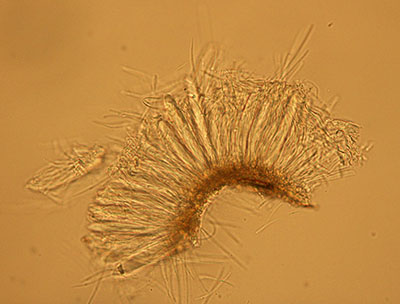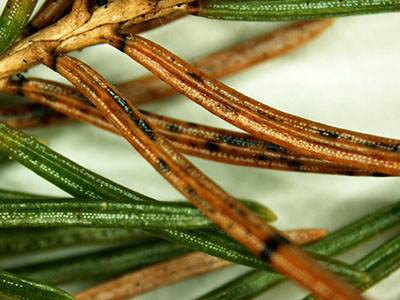Lirula needle blight found on Black hills spruce
Browning interior needles caused by Lirula macrospora are being found on Black hills spruce.

Recent samples of browning interior needles on Black hills spruce sent to Michigan State University Diagnostic Services found Lirula needle blight. Lirula needle blight is caused by the fungus Lirula macrospora. Hosts include Colorado blue spruce (Picea pungens), and white spruce (Picea glauca). White spruce, including Black hills spruce, is a more susceptible species. Unlike other needlecasts we find on spruce, the brown needles killed by Lirula can remain attached for several years.
Lirula macrospora takes several years to complete its lifecycle. The fungus overwinters in infected needles on the tree. In late spring through midsummer, infected needles release spores that spread by splashing and dripping rain to new needles. The current year’s needles appear to be the most susceptible. On second year needles, you will find a raised black line, which is a spore producing structure on the midrib on the underside of the needle. Spores are released from these structures on third year needles.
Not much is known about controlling Lirula. MSU Extension recommends following these general plant health guidelines:
- Inspect nursery stock for signs of infection.
- Avoid planting spruce where Lirula needle blight occurs.
- Promote good air movement by providing adequate spacing or controlling weeds.
- Shear healthy trees first and disinfect tools often.
- Remove heavily infected trees.
Currently, no information is available on the effectiveness of fungicides for control of this disease. Protectant fungicides effective against other needlecast diseases such as chlorothalonil or mancozeb may provide control. For more information, visit the University of Minnesota Extension Lirula needle blight fact page.

Microscopic view of spore producing structure in the needle. Photo: Jan Byrne, MSU.

Spores are produced beneath the elongated, slightly raised, black line along the infected needles. When the spores are mature, a crack in the needle opens along this line. Photo: Jan Byrne, MSU.



 Print
Print Email
Email


